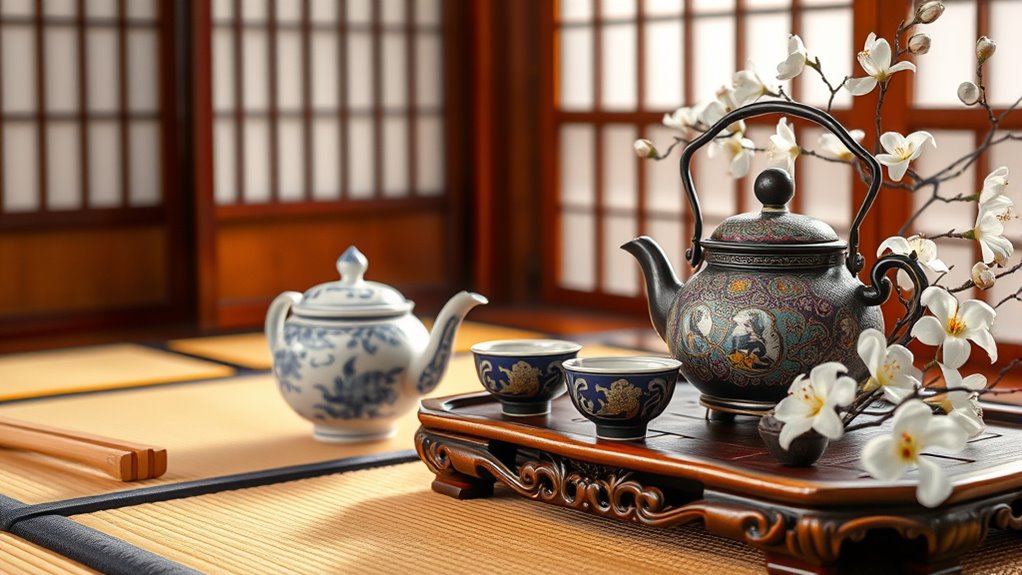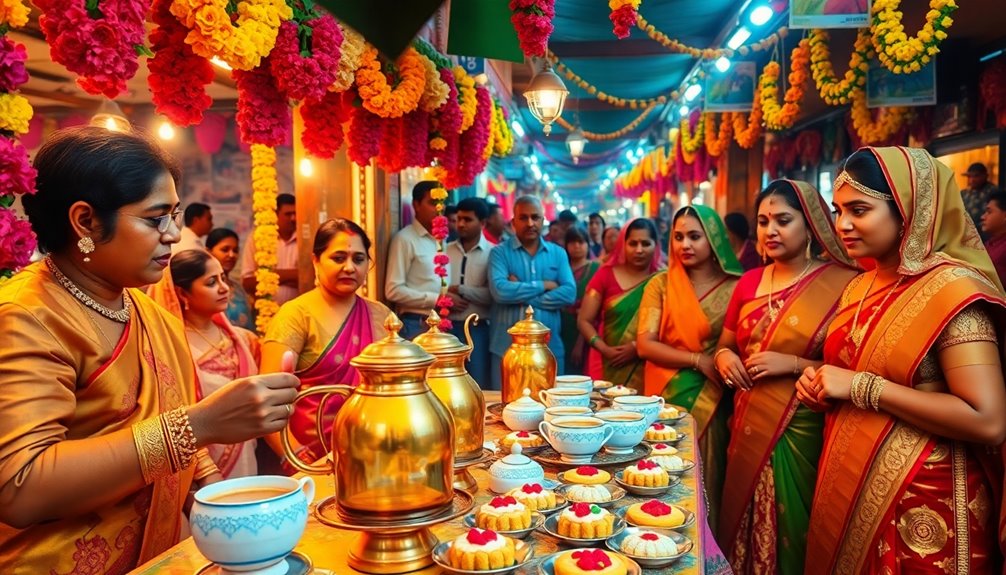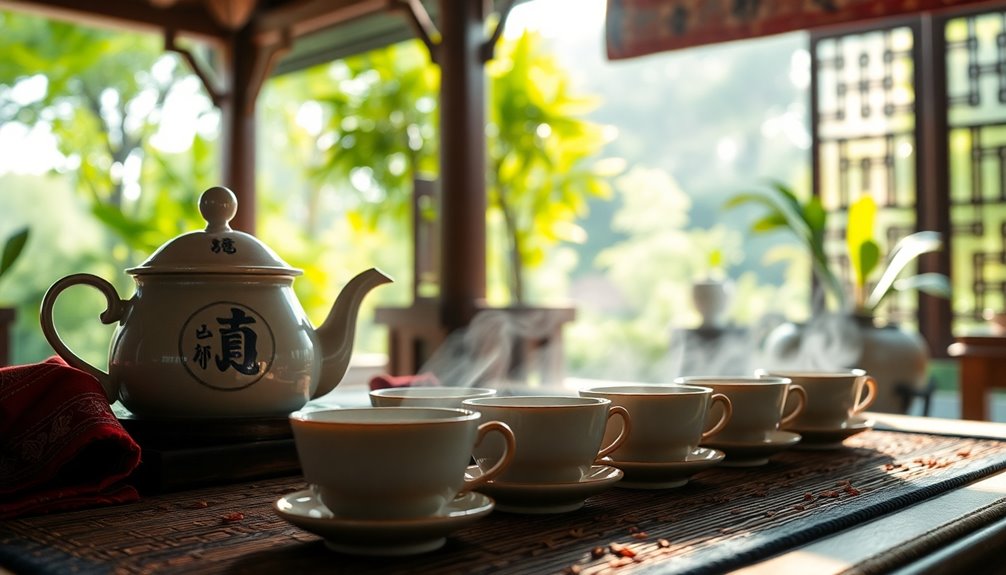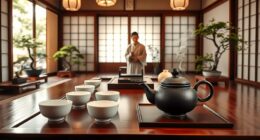In many cultures, tea is more than just a drink—it symbolizes respect, hospitality, and tradition. For example, in Japan, the tea ceremony emphasizes mindfulness, harmony, and reverence through precise rituals. Chinese tea rituals focus on politeness and honoring relationships, while Moroccan mint tea reflects warmth and generosity with lively, social gestures. These customs highlight unique values and social bonds, turning simple tea sharing into meaningful cultural acts. Exploring these traditions reveals richer insights into each society’s core values.
Key Takeaways
- Tea serves as a symbol of hospitality, respect, and tradition across diverse cultures worldwide.
- Japanese tea ceremonies emphasize mindfulness, harmony, and reverence through precise, ritualistic actions.
- Chinese tea etiquette involves respectful gestures like serving with both hands and maintaining social harmony.
- Moroccan mint tea rituals are lively, emphasizing warmth, generosity, and social bonding during preparation and serving.
- Across cultures, tea rituals reinforce social bonds, cultural identity, and symbolize values such as respect, harmony, and community.
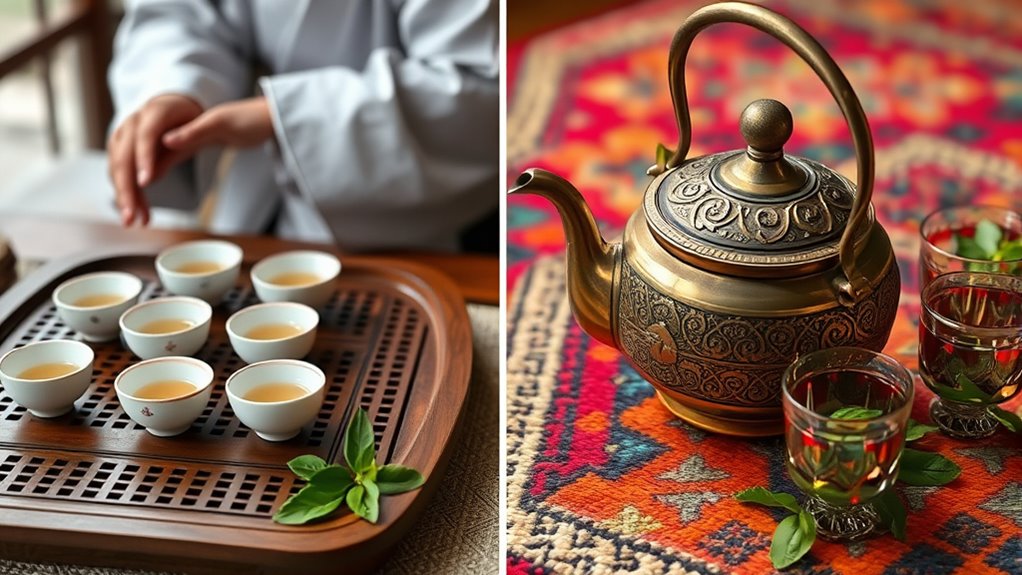
Tea is more than just a beverage; it’s a powerful symbol of hospitality, respect, and tradition across many cultures. When you partake in tea, you’re often engaging in more than just drinking—you’re participating in a ritual that embodies centuries of cultural values. In many societies, the way you prepare tea and the ceremonial rituals involved hold deep significance, conveying honor and social connection. For example, in Japan, the art of tea preparation is elevated to a spiritual practice known as the tea ceremony or “chanoyu.” You’re expected to approach this ritual with mindfulness, paying close attention to each movement, from whisking the powdered matcha to pouring the hot water. The entire process emphasizes harmony, respect, purity, and tranquility. During these ceremonies, the precision and grace of your actions aren’t just about making tea; they symbolize respect for tradition and the guests present. Every step is deliberate, reinforcing a sense of calm and reverence that transcends the simple act of drinking tea. Additionally, the ritualistic nature of tea ceremonies serves to strengthen social bonds and uphold cultural identity through shared practices.
Similarly, in China, tea preparation and ceremonial rituals are steeped in history and social etiquette. When you serve tea in a Chinese setting, it’s customary to present it with both hands, showing respect to your guests. The process often involves carefully selecting the tea leaves, boiling water to the right temperature, and pouring with a gentle yet confident hand. The act of offering tea is a gesture of politeness and hospitality, often accompanied by specific rituals like bowing slightly or serving from a particular angle. These practices are rooted in Confucian values that emphasize filial piety, respect, and social harmony. The ceremonial aspect underscores the importance of maintaining good relationships and honoring tradition, making the simple act of pouring tea a meaningful expression of cultural identity.
In Morocco, the preparation of mint tea is a lively, almost theatrical event. You’re expected to perform the process with flair—boiling the water, adding fresh mint and sugar, and pouring from a height to aerate the tea. This process isn’t just about taste; it’s about creating an atmosphere of warmth and generosity. Serving tea here is an act of hospitality, signaling that your guests are valued and welcomed. The ceremonial rituals involved are often accompanied by storytelling, laughter, and shared moments that reinforce social bonds. Whether it’s the delicate pouring in Japan, the respectful gestures in China, or the spirited serving in Morocco, each culture’s approach to tea preparation and ritual highlights its unique values and social codes. Engaging in these customs allows you to connect more deeply with the traditions and people you’re sharing tea with, transforming a simple drink into a meaningful cultural experience.
Frequently Asked Questions
How Do Tea Customs Vary Between Rural and Urban Areas?
In rural areas, you’ll find tea customs focus on warm rural hospitality, where sharing tea is about community and simple traditions. In contrast, urban sophistication shapes tea practices with elegant rituals, refined presentation, and a focus on presentation and finesse. You notice that rural gatherings emphasize warmth and connection, while urban settings highlight formality and style, reflecting the different social dynamics and cultural values in each environment.
Are There Specific Gestures to Avoid During Tea Ceremonies?
When participating in tea ceremonies, avoid using impolite gestures like pointing with your chopsticks or tapping the teacup loudly. It’s best to keep your hands relaxed and show respectful posture. Refrain from interrupting or speaking loudly, as these are considered inappropriate behaviors. Always handle the teacup with both hands when receiving or offering tea, and don’t rush the process—these polite gestures show your respect for the tradition.
How Has Modern Culture Influenced Traditional Tea Etiquette?
You might be surprised, but modern culture has subtly reshaped tea etiquette in unexpected ways. As global influences grow, traditions evolve, blending old customs with new trends. Social media, for instance, promotes casual sharing, while quick service alters formalities. This tea etiquette evolution reflects how modern cultural influences challenge and enrich traditional practices, creating a dynamic, interconnected world where respect and innovation coexist around every cup you sip.
What Are the Historical Origins of Tea Symbolism in Different Societies?
You learn that tea symbolism has deep roots in cultural origins, reflecting values like harmony, purity, and hospitality. In China, tea symbolizes respect and spiritual harmony, while in Japan, it embodies Zen principles through the tea ceremony. In Britain, tea became a symbol of social connection and civility. These cultural origins shape how societies view tea, turning simple leaves into meaningful symbols of tradition, unity, and identity.
How Do Age and Social Status Impact Tea-Serving Manners?
When you serve tea, you notice that age and social status influence your manners like a well-choreographed dance. You show generational respect by bowing slightly or using formal language, and you honor social hierarchy by serving elders first or offering a more refined cup. It’s a delicate balance where you navigate these customs gracefully, understanding that respecting tradition keeps the social fabric tight and the ceremony meaningful.
Conclusion
As you sip your tea, remember it’s more than just a drink—it’s a bridge between cultures, a dance of gestures, and a reflection of history. Each delicate swirl in your cup carries stories of tradition and respect, inviting you to appreciate the deeper meanings behind every gesture. Embrace these customs, and let the warm aroma and gentle pour remind you that tea is a universal language connecting hearts across the world.

